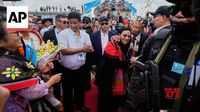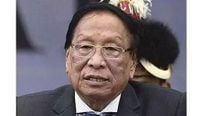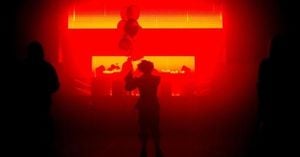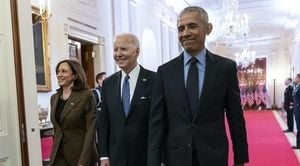On October 22, 2025, the usually quiet hills of Manipur’s Ukhrul district erupted in jubilation. A helicopter sliced through the clear, blue sky, descending into the heart of Somdal village. On the ground, thousands of people—many dressed in vibrant traditional Naga attire, some wielding spears and donning feathered headgear—waited with anticipation. Schoolchildren waved flags adorned with a blue background, a rainbow arching across its center, and a white star in the top left corner. The excitement was palpable: Thuingaleng Muivah, the 91-year-old general secretary of the National Socialist Council of Nagalim (Isak-Muivah), or NSCN (I-M), was returning to his birthplace after more than fifty years.
Muivah’s homecoming was not just a personal journey. It was a moment loaded with political symbolism and historical resonance for the Naga people, an Indigenous community whose homeland stretches across Nagaland, Manipur, Arunachal Pradesh, and Assam in India’s northeast. According to the Associated Press, the last time Muivah set foot in his home state was in 1973. His previous attempt to visit in 2010 was blocked by the Manipur government, sparking deadly protests and deepening the sense of estrangement between the state and the Naga movement.
As Muivah stepped onto the soil of Somdal, he was greeted by chants, music, and an outpouring of affection from people who had waited decades for his return. The event was more than a reunion; it was a statement. Muivah used the occasion to renew his call for a "sovereign Nagalim," a demand that has long been at the center of the decades-old Naga peace talks with the Indian government. The push for a separate Naga homeland—one with its own flag and constitution—has been both the rallying cry and the stumbling block in negotiations for peace.
"The Naga national flag and the Naga national constitution are non-negotiable, whether it is today or tomorrow," Muivah declared during his historic homecoming, as reported by multiple outlets including The Times of India and AP. His words underscored the hardened stance of the NSCN (I-M), which has led the Naga insurgency since the 1950s. While violence has diminished since a 1997 ceasefire, the core issues remain unresolved, keeping the peace process in a state of limbo.
The Naga insurgency’s roots stretch back to the 1950s, when aspirations for independence and self-determination first ignited. Over the years, the movement has evolved, but its central demand—a distinct identity for the Naga people, enshrined in their own constitution and symbolized by their own flag—remains unchanged. Muivah, who left his home in 1964 to join the independence movement, has become the face of this enduring struggle. His leadership has guided the NSCN (I-M) through decades of underground resistance, negotiations, and intermittent violence.
The peace talks, which Muivah now leads on behalf of the Naga side, have been at an impasse for years. The Indian central government has made it clear that any solution must fall within the framework of the Indian Constitution. According to The Times of India, no government sworn to uphold India’s sovereignty can agree to demands that would violate constitutional provisions—namely, a separate flag and constitution for Nagalim. However, the Indian Constitution does provide for significant autonomy under the Sixth Schedule, which has been used to address similar demands elsewhere in the northeast.
A case in point is the Bodoland Territorial Council, created under the amended provisions of the Sixth Schedule. This arrangement convinced armed Bodo groups to abandon their quest for statehood and sovereignty in favor of autonomy, which has brought about rapid development and the safeguarding of their language and culture. The government hopes a similar model could persuade the Nagas to settle for enhanced autonomy rather than outright independence.
The central government has also floated the idea of a Pan Naga Hoho—a non-political, social, and cultural institution designed to promote and preserve Naga traditions, heritage, and customs across state boundaries. While this proposal addresses the cultural aspirations of the Naga people, it stops short of granting any political power that might infringe on the territorial jurisdictions of Assam, Manipur, or Nagaland. According to The Times of India, any political body with overlapping powers would be a non-starter for both the central government and the neighboring states.
In a significant development just days before Muivah’s visit, the Nationalist Democratic Progressive Party (NDPP) and the Naga People’s Front (NPF)—the two main regional parties—announced a merger under the NPF banner. This move, reported by The Times of India, is expected to shift the political dynamics in Naga-inhabited areas of Manipur, Arunachal Pradesh, and Nagaland. The unified party is likely to consolidate its organizational base and could play a crucial role in influencing ongoing negotiations between the NSCN (I-M) and the central government.
The hope among many observers is that the strengthened NPF, with its experience in governance and its roots in the Naga community, can help bridge the gap between the insurgent leadership and the realities on the ground. There is an urgent need, as highlighted by The Times of India, for renewed efforts by the Neiphiu Rio-led NPF coalition government to resume sustained dialogue. The longer the deadlock persists, the more the Naga people—especially the youth—risk being deprived of the benefits of development, education, and improved infrastructure.
Yet, the path forward is anything but straightforward. The NSCN (I-M) continues to insist that only a settlement recognizing the Naga flag and constitution will be acceptable. The central government, for its part, is adamant about preserving the integrity of the Indian state. The creation of a Pan Naga Hoho might offer a way to honor Naga identity without redrawing state boundaries, but it remains to be seen whether this compromise will satisfy the aspirations of the Naga people or the leadership of the NSCN (I-M).
As the peace process hangs in the balance, the stakes could not be higher. The Northeast region stands on the threshold of a new era of progress and development, but the uncertainty surrounding the Naga issue threatens to leave an entire generation behind. The onus is now on all sides—the NSCN (I-M), the unified NPF, and the central government—to make an honest assessment of ground realities, listen to the hopes and fears of ordinary Nagas, and find a pragmatic path to a final settlement.
For now, Muivah’s homecoming has reignited old passions and brought the Naga issue back into sharp national focus. Whether this historic moment will mark the beginning of a new chapter in the quest for peace, or simply another turning point in a long, unfinished story, remains to be seen.





